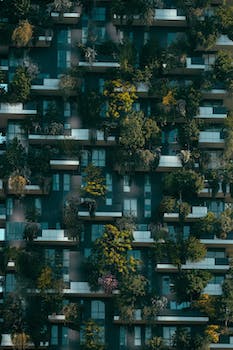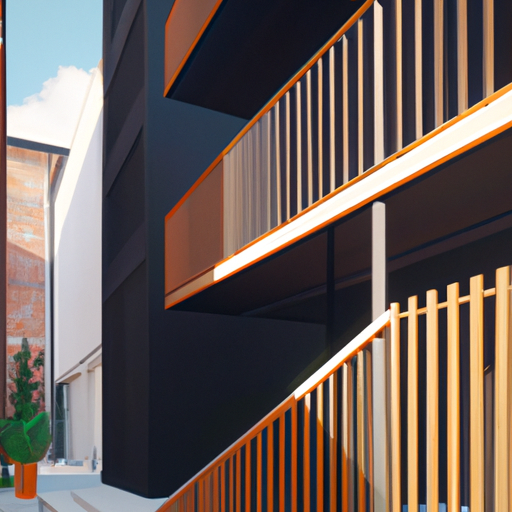Integrating Technology and Sustainability in Teen-Friendly Complex Designs
Designing a modern complex that caters to the unique needs and preferences of teenagers requires a thoughtful approach that combines technology, sustainability, and teen-friendly amenities. As the generation that has grown up with smartphones, social media, and a heightened awareness of environmental issues, today’s teenagers are more connected and environmentally conscious than ever before. Therefore, it is essential for architects and designers to create spaces that not only appeal to their interests but also promote sustainable living and foster a sense of community.
One of the key aspects of designing a modern complex for teenagers is the seamless integration of technology. This can be achieved by incorporating smart building systems that allow for remote control and monitoring of various aspects of the complex, such as lighting, heating, and security. Additionally, providing high-speed Wi-Fi connectivity throughout the complex is essential for enabling teenagers to stay connected with their friends and access online resources for schoolwork and entertainment. Furthermore, incorporating interactive digital displays and touchscreens in common areas can provide a platform for teenagers to engage with information about the complex, local events, and environmental initiatives.
Another important consideration in designing a teen-friendly complex is the inclusion of sustainable features that promote eco-friendly living. This can be achieved by incorporating energy-efficient systems, such as solar panels, green roofs, and rainwater harvesting systems, which not only reduce the complex’s environmental footprint but also provide educational opportunities for teenagers to learn about sustainable practices. Additionally, using sustainable building materials, such as reclaimed wood and recycled metal, can further contribute to the complex’s green credentials and create a visually appealing aesthetic that resonates with environmentally conscious teenagers.
In addition to technology and sustainability, the design of a modern complex for teenagers should also focus on creating spaces that foster social interaction and a sense of community. This can be achieved by incorporating a variety of communal spaces, such as lounges, study areas, and outdoor gathering spots, where teenagers can socialize, collaborate on projects, or simply relax and unwind. Furthermore, providing amenities that cater to the diverse interests of teenagers, such as sports facilities, gaming rooms, and art studios, can help create a vibrant and dynamic environment that encourages teenagers to engage with their peers and explore new hobbies and interests.
To further enhance the appeal of a modern complex for teenagers, designers should also consider incorporating elements of biophilic design, which seeks to connect occupants with nature and promote well-being. This can be achieved by integrating natural materials, such as wood and stone, into the building’s design, as well as incorporating greenery and water features throughout the complex. Additionally, providing ample natural light and views of the outdoors can help create a more inviting and comfortable environment for teenagers to spend their time.
In conclusion, designing a modern complex that is perfect for teenagers requires a multifaceted approach that combines technology, sustainability, and teen-friendly amenities. By seamlessly integrating smart building systems, sustainable features, and communal spaces that foster social interaction, architects and designers can create a dynamic and eco-friendly environment that appeals to the unique needs and preferences of today’s connected and environmentally conscious teenagers. Furthermore, incorporating elements of biophilic design can help promote well-being and create a more inviting and comfortable atmosphere for teenagers to thrive.
Creating Engaging and Interactive Spaces for Teenagers in Modern Complexes

Designing a modern complex that caters to the unique needs and preferences of teenagers can be a challenging task. Teenagers are a diverse group with varying interests, and creating a space that appeals to them requires a thoughtful approach that balances functionality, aesthetics, and interactivity. In this article, we will explore some key considerations for designing a modern complex that is perfect for teenagers, focusing on the creation of engaging and interactive spaces.
One of the most important aspects of designing a modern complex for teenagers is understanding their needs and preferences. Teenagers are at a stage in their lives where they are developing their own identities and exploring new interests. As such, it is crucial to create spaces that cater to a wide range of activities and hobbies. This can be achieved by incorporating multipurpose spaces that can be easily adapted to different uses, such as study areas, lounges, and recreational facilities. By providing a variety of spaces that cater to different interests, teenagers will be more likely to engage with the complex and feel a sense of ownership over the space.
Another key consideration when designing a modern complex for teenagers is the importance of technology. Today’s teenagers are digital natives, having grown up with technology as an integral part of their lives. As such, it is essential to incorporate technology into the design of the complex in a way that is both functional and aesthetically pleasing. This can include providing high-speed Wi-Fi access throughout the complex, installing interactive touchscreens and digital displays, and incorporating charging stations for electronic devices. By integrating technology seamlessly into the design, the complex will not only meet the needs of tech-savvy teenagers but also create a modern and forward-thinking atmosphere.
In addition to technology, the design of a modern complex for teenagers should also prioritize sustainability and environmental consciousness. Teenagers today are more aware of environmental issues than ever before, and many are passionate about making a positive impact on the planet. By incorporating sustainable design elements such as energy-efficient lighting, water-saving fixtures, and green spaces, the complex can demonstrate a commitment to environmental responsibility and appeal to eco-conscious teenagers.
Creating a sense of community is another important aspect of designing a modern complex for teenagers. Teenagers are social creatures, and providing spaces that encourage interaction and collaboration can help foster a sense of belonging and camaraderie. This can be achieved by incorporating communal spaces such as shared lounges, outdoor seating areas, and group study rooms. Additionally, the complex can host events and activities that cater to different interests, such as art workshops, fitness classes, and movie nights. By creating opportunities for socialization and connection, the complex can become a hub for teenagers to gather and engage with one another.
Finally, the aesthetic design of the complex should be carefully considered to create an environment that is both visually appealing and conducive to productivity and relaxation. This can be achieved by using a mix of natural materials, such as wood and stone, and incorporating elements of biophilic design, such as indoor plants and natural light. The color palette should be calming and inviting, with a mix of neutral tones and pops of color to create visual interest. By creating a visually appealing and comfortable environment, the complex will be more likely to attract and retain teenage visitors.
In conclusion, designing a modern complex that is perfect for teenagers requires a thoughtful approach that balances functionality, aesthetics, and interactivity. By understanding the unique needs and preferences of teenagers, incorporating technology and sustainable design elements, fostering a sense of community, and creating a visually appealing environment, designers can create engaging and interactive spaces that cater to the diverse interests of today’s teenagers.
Balancing Privacy and Socialization in Teen-Centric Complex Design
Designing a modern complex that caters to the unique needs and preferences of teenagers can be a challenging task. Teenagers are at a stage in their lives where they are transitioning from childhood to adulthood, and their needs for privacy and socialization are constantly evolving. As such, architects and designers must strike a delicate balance between providing spaces that allow for both privacy and social interaction, while also ensuring that the complex remains functional, safe, and aesthetically pleasing.
One of the key aspects of designing a teen-centric complex is understanding the importance of privacy for teenagers. As they grow older, teenagers begin to develop a stronger sense of individuality and independence, and they often seek out spaces where they can express themselves without the constant supervision of adults. This can be achieved by incorporating private nooks and crannies throughout the complex, such as quiet study areas, secluded outdoor spaces, and individual rooms for music practice or art creation. These spaces should be designed in such a way that they are easily accessible, yet still provide a sense of seclusion and personal space.
In addition to private spaces, it is also crucial to provide areas where teenagers can socialize and interact with their peers. Socialization is a vital aspect of adolescent development, as it helps teenagers build relationships, develop communication skills, and learn how to navigate the complexities of group dynamics. To facilitate this, designers should include communal spaces that encourage interaction and collaboration, such as lounges, game rooms, and outdoor gathering areas. These spaces should be equipped with comfortable seating, tables for group work, and technology that supports both entertainment and learning, such as Wi-Fi access and charging stations for electronic devices.
Another important consideration when designing a modern complex for teenagers is the need for flexibility. Teenagers’ interests and needs can change rapidly, and the spaces within the complex should be adaptable to accommodate these shifts. For example, multipurpose rooms can be used for a variety of activities, such as study sessions, club meetings, or movie nights, depending on the needs of the residents. Similarly, outdoor spaces can be designed with movable furniture and landscaping elements that can be rearranged to create different configurations for various events and activities.
Safety is also a paramount concern when designing a complex for teenagers. Designers should ensure that the complex is well-lit, with clear sightlines and minimal hidden corners where unsupervised activities could take place. Additionally, incorporating security measures such as surveillance cameras, secure entry points, and on-site staff can help to create a safe environment for residents.
Finally, aesthetics play a significant role in creating a welcoming and appealing environment for teenagers. The design of the complex should be modern and visually engaging, with a mix of textures, colors, and materials that reflect the diverse interests and personalities of its residents. Artwork, murals, and other creative elements can be incorporated throughout the complex to add visual interest and inspire creativity among the residents.
In conclusion, designing a modern complex that is perfect for teenagers requires a careful balance of privacy and socialization, as well as considerations for flexibility, safety, and aesthetics. By incorporating private spaces for individual expression, communal areas for social interaction, and adaptable spaces that can accommodate changing needs, architects and designers can create a complex that not only meets the unique needs of teenagers but also fosters a sense of community and belonging.
Q&A
Question 1: What are the essential facilities and spaces to include in a modern complex for teenagers?
Answer: Essential facilities and spaces for a modern complex for teenagers include a variety of recreational areas such as sports courts, gaming zones, and creative spaces; educational and skill development centers like libraries, computer labs, and workshops; social spaces like cafes, lounges, and outdoor seating areas; and support services such as counseling centers, healthcare facilities, and security measures.
Question 2: How can the design of a modern complex promote social interaction and a sense of community among teenagers?
Answer: To promote social interaction and a sense of community among teenagers, the design should incorporate open and flexible spaces that encourage collaboration and group activities. This can be achieved by including multi-purpose rooms, communal seating areas, and outdoor gathering spaces. Additionally, incorporating art, cultural elements, and technology can create an inviting atmosphere that fosters communication and connection.
Question 3: What are some sustainable design features that can be incorporated into a modern complex for teenagers?
Answer: Sustainable design features for a modern complex for teenagers include energy-efficient lighting and HVAC systems, solar panels or other renewable energy sources, green roofs and walls, rainwater harvesting systems, efficient waste management and recycling facilities, and the use of eco-friendly materials and finishes. Additionally, incorporating natural light, ventilation, and green spaces can improve the overall well-being of the occupants and reduce the complex’s environmental impact.
Conclusion
In conclusion, designing a modern complex that is perfect for teenagers involves incorporating elements that cater to their interests, needs, and preferences. This includes creating spaces for socializing, learning, and entertainment, as well as ensuring safety, accessibility, and sustainability. By combining these elements, a modern complex can provide an engaging and supportive environment that fosters personal growth, creativity, and a sense of community among teenagers.


